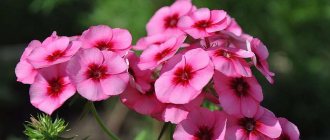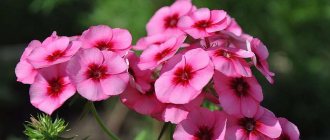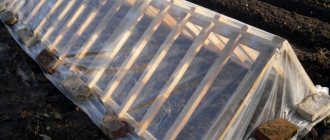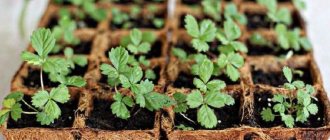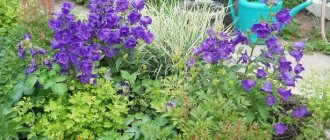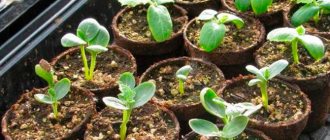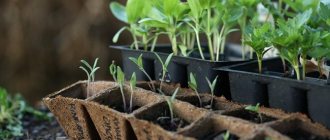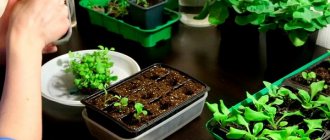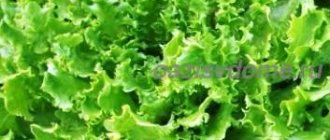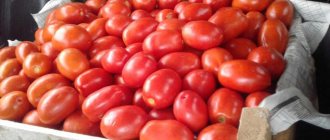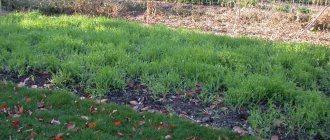Petunia is a favorite ornamental crop of most gardeners. The bright flowers of this wonderful plant can decorate an area like a scattering of precious stones. In addition, petunia is actively used as a potted crop, with which balconies, verandas and terraces are decorated. There are several types of petunias, differing in flower shape and size. However, sowing petunia for seedlings is almost the same for each of these species.
Sowing petunias for seedlings
To achieve high-quality flowering of the crop, great efforts should be made. And it’s not surprising, because growing petunia seedlings is considered a true art, and if you don’t master it, you’re unlikely to achieve good results. We will try to understand the peculiarities of sowing petunia so that you do not end up with bitter disappointment.
Petunia seedlings
Sowing petunia according to the LUNAR CALENDAR in 2022
To begin with, we provide a list of favorable and unfavorable days in order to know when it is recommended to plant petunia seedlings in 2022 according to the lunar calendar, and when, on the contrary, you should refrain from sowing.
- Favorable days in 2022:
- January
– 3, 8, 9, 10, 11, 15, 16, 23, 24 - February
– 3, 4, 7, 8, 9, 10, 11, 12, 13, 14, 15, 22, 23 - March
– 3, 6, 7, 8, 10, 11, 12, 16, 17, 21, 22, 23, 29, 30 - April
– 3, 4, 5, 6, 7, 9, 12, 13, 14, 15, 26, 27
Unfavorable days for planting will fall, as usual, on new and full moons. Also, if possible, it is better to avoid those days when the moon is in the sign of Aquarius (one of the most barren periods).
- Unfavorable days in 2022:
- January – 2, 4, 5, 18
- February – 1, 2, 16, 28
- March – 1, 2, 18, 27, 28
- April – 1, 16, 23, 24, 25
For those who are used to navigating by the lunar calendar, a list of specific dates is certainly necessary information. However, it is worth little if you don’t know in what month it is better to plant petunia in your region, what is the difference between the planting times for hanging and bush varieties, when you need to plant these plants, based on the length of daylight hours and the required time for the start of flowering. It is this information that will help you start sowing on time, so that the plants will then develop normally and be able to bloom together. We recommend that you continue reading and learn more about planting dates, as well as how to organize the process itself as simply as possible.
Propagation of petunia from cuttings
Rooted cuttings
This method is usually used for propagating double large-flowered varieties. Cuttings are taken from healthy, developed mother plants, which are kept in winter in a bright, well-ventilated, cool room at a temperature of 10-12 °C. Cut cuttings 6-8 cm long, leaving 2 to 4 leaves.
When propagated by seeds of varieties with double flowers, only 40-50% of the “daughter” plants turn out to be double. That is why the cutting method is used to propagate such petunias.
Cuttings are planted in December-January in pots or picking boxes, which need to be filled with sand or a mixture of sand and peat. They take root at a temperature of 18-20 °C. As they grow, rooted cuttings are transferred to larger pots. Such plants bloom in 4-5 months.
We choose the timing of when to plant petunia seedlings in different regions
It is important to understand when planting time is in your region. For different climatic conditions, the optimal periods will be quite different.
Middle zone (Moscow region)
The most suitable time throughout the middle zone will be:
February March
Southern regions
Here you can start planting earlier. It is perfectly acceptable to sow:
from the second half of January
North-West, Urals, Siberia, Far East
In these regions, the timing is quite extended and depends on additional lighting when growing seedlings (more on this later) and the location of further planting of seedlings. In general, it is better not to rush and plant during the following period:
end of February – beginning of April
Features of the plant
Flowers such as petunia attract attention with their diversity, variegated color and unique inflorescence shape. They first appeared in France, and the plant was brought by the famous botanist Lamarck, who mistakenly mistook petunia for a type of tobacco.
Petunia looks equally beautiful in a flower bed, lawn and on the windowsills of apartments or private houses.
It quickly fills the space and begins to hang out beautifully, as the stems not only branch, but also become woody. Flexibility and color are preserved.
The average height of seedlings is 75 cm, but this depends on the variety. There are sticky hairs on the green part of the plant. Peduncles are elastic, short.
They are the basis for the bud. The number of flowers is unlimited. Due to this feature, petunia is spectacular and attractive.
How seedling planting conditions affect sowing dates
Now let's look at the important clarifications regarding the above deadlines.
From the moment of sowing petunia for seedlings until transplanting the seedlings to a permanent place, 11-13 weeks should pass.
Focus on these numbers. That is, if you plan to plant seedlings in open ground in early June, then you need to sow in early March. Petunia is a heat-loving plant, so be sober about when it can be moved to a permanent location. The landing conditions for it should be as follows:
- There is no threat of return frosts.
- The soil warmed up to +10-12 degrees.
Think about when this time comes in your area, and count back the indicated 11-13 weeks to determine the earliest sowing time. For example, in the middle zone (Moscow region), the planting time that meets the requirements is in the second half of May, which means that you can sow from approximately mid-February.
When making these calculations, keep in mind that petunia is also very light-loving. If you have phytolamps and the ability to supplement the seedlings literally from the moment of sowing, then you can safely plant the seeds in February or even January, but if not, then you should not sow them before March. With a lack of lighting, seedlings, unfortunately, easily stretch out and become thin and weak.
With additional lighting, petunia can be planted as seedlings much earlier; without additional lighting, it is better not to rush and sow no earlier than March, regardless of the region.
Additional lighting is required in winter
If for some reason you want to start planting earlier, but you won’t be able to provide additional light to the seedlings, then choose the brightest window to place them and in the future be sure to pinch the bushes so that they branch better and are denser, but know that the risk is still very high that young plants will be weakened.
If you plan to plant seedlings not in open ground, but place them, for example, on a warm glazed balcony or in another place where it will be comfortable regardless of the weather, and at the same time you have the opportunity to supplement the seedlings for a long time, then the sowing dates can be moved further the earlier side. In this case, it is possible to sow even at the beginning of January, and get well-developed plants already at the end of March - April. But this is still rather an exception, since mostly petunias, of course, are intended for planting in the open air.
Pinching
Pinching is the removal of the top part of an overgrown shoot. It is an important stage in growing and caring for seedlings; it is necessary for the formation of petunia and future lush flowering. This effect is achieved due to the elimination of the elongated upper part of the plant, which promotes the growth of shoots in different directions.
These instructions will help you correctly pinch seedlings at home:
- The activity should be carried out only when the flower has grown, stretched, and become stronger; it should grow rapidly upward, and it should also have two or three pairs of true leaves.
- Pinching is best done after picking or transplanting into open ground.
- For proper pinching, you need to determine the right place on the stem (it is located approximately three to five leaves from the bottom of the plant). Then you should pinch off the top shoot in this place.
By the way! You can pinch with your fingers, or with pruning shears or scissors.
Video: how and when to pinch petunias.
We sow ampelous and bush petunias at different times
Depending on what type of plant - hanging or bush - you plan to grow, the optimal planting time will be slightly different.
- Reference:
- Ampelous - have long (50-120 cm) flexible shoots. Ideal for hanging planters and vertical gardening.
- Bush - have erect shoots, either compact (up to 30 cm), or spreading and quite long (up to 60 cm). Used in various flower beds.
Ampelous varieties and hybrids require a little more time to grow and develop. They are sown earlier.
It is better to sow ampelous petunias 2 weeks earlier than bush petunias.
Hanging varieties are very effective in hanging flowerpots
Diseases
In the early stages of development, while the seedlings have a thin stem and are practically devoid of a root system, they are threatened by “black leg” - a fungal disease whose pathogens live in the soil and are activated when the watering regime and temperature indicators are not observed (below 20 º C). If the fall of seedlings is detected, it is necessary to dry the soil and remove all affected seedlings, sprinkle the soil with calcined cooled sand.
Viral diseases are manifested by deformation of leaves and flowers, they lose their varietal qualities and appearance. Such plants must be destroyed.
Deciding when to sow in order to achieve flowering in the right month: April, May, June, July
Petunia seedlings, as a rule, are planted already flowering, which is due to the peculiarities of the growing season of this crop: from sowing to planting, as already mentioned, approximately 3 months pass, and less - about 2.5 months until the flowers appear (the first buds may appear even earlier, especially if the variety is early). So it turns out that young plants often bloom even before they are transplanted to a permanent place.
Therefore, if you need to get flowering bushes by a certain date, then subtract 2.5 - 3 months from it.
It turns out:
- To achieve flowering in mid-April, you need to sow in mid-late January (mandatory long-term additional lighting will be required)
- To achieve flowering in mid-May, you need to sow in mid-late February (at first you will need additional lighting)
- To achieve flowering in mid-June, you need to sow in mid-late March
- To achieve flowering in mid-July, you need to sow in mid-late April
What is needed to make a snail?
You will need few consumables and tools. As a rule, all of them can be found in any household.
Necessary materials for making a snail:
- foamed polyethylene as a backing for laminate;
- roll of toilet paper;
- a spray bottle filled with warm, settled water;
- thin elastic bands to hold the snail in a curled form;
- scissors;
- soil mixture for petunias;
- adhesive colored strips for marking.
Everything necessary is prepared in advance so that the materials are at hand.
Choosing suitable seeds
Further subtleties concern not the timing, but the preparation and the planting process itself. It must be said that there are quite a lot of nuances in this matter. First you need good seed material. After a certain time, it loses its viability, so you should avoid overdue ones that have been stale.
The shelf life of petunia seeds is up to 5 years.
But if possible, it is, of course, better not to keep them for that long - as practice shows, their optimal germination is within 3 years. However, during storage it is important that they are kept in suitable conditions: a dry and dark place. Best when cool. Sometimes there is a direct indication on the packages that it is recommended to store them in the refrigerator - at such temperatures, viability lasts longer. It follows that:
For better germination, we take fresh seeds - 1-3 years old.
Older (up to 5 years) planting material can also be used, but only if all storage conditions have been met, and then there are no guarantees in this case.
The bags are best stored in the refrigerator
Petunia seeds are very small (0.5 mm in diameter) and dark, merging with the color of the soil. Planting such crumbs is problematic, so manufacturers have now mainly switched to producing them in pelleted form: they are covered with a special colored nutritious shell, which makes them larger and more noticeable.
At the stage of selecting varieties and hybrids for planting, decide what type of seeds you will sow - regular or pelleted. Both have a number of advantages and disadvantages.
Regular seeds:
- Minuses
- very small
- poor assortment today
- indistinguishable on the ground
- pros
- cheap
- no additional dissolution of the shell is required
Dried seeds in capsule
Dried seeds:
- Minuses
- the shell sometimes dissolves with great difficulty
- expensive
- small quantity per package
- You may get empty pellets
- pros
- larger than normal size
- have a noticeable color
It is better to take planting material from trusted agricultural companies, since the germination of petunia seeds is a sore subject. Even fresh ones, alas, can sprout poorly.
Due to their extremely small size, petunia seeds are difficult to plant, and for the same reason they are not subjected to any pre-sowing treatment - this is simply unrealistic.
Preparing for sowing
Seed selection
Seeds for sowing can be bought at a specialized store, or you can leave a few flowers from last year until the year is fully ripe and collect it yourself. You just need to know for sure that the chosen plant is not a hybrid, since the seeds of hybrids can inherit the variety of one of their “parents” and the flower will not grow as expected.
So, it was decided to collect the seeds yourself; to do this, select several lower flowers, mark them with a bright thick thread, and these flowers are no longer removed after they have faded. It takes about two months from the full opening of the flower to the formation of seeds.
Seeds are formed in boxes, and there is a possibility of missing the moment of collection and the seeds may simply spill out onto the ground. To prevent this from happening, you can put a disposable tea bag on the box and then the seeds will definitely be collected on time.
Requirements for soil mixture
The soil can be either store-bought or prepared independently in the fall, the main thing is that it contains
- Turf;
- Humus;
- Peat;
- Sand.
All components must be taken in equal parts.
If the soil is acidic, lime should be added.
Whatever soil is used, it must be disinfected before use. Sprinkle with a solution of potassium permanganate. You can also pour boiling water or bake it in the oven.
Preparing seeds for sowing
Seeds need to be stratified. To do this, the seeds need to be mixed with sifted river sand, put them in a paper bag or box, wrapped in cellophane and placed in the refrigerator for one and a half to two months.
When sowing seeds “in the snow,” this operation can be skipped.
To increase germination, you can soak the seeds 10-12 hours before planting in a weak solution of potassium permanganate or epin.
Important! If the seeds are sown based on the lunar calendar, then the day of soaking the seeds will be considered a favorable day.
Preparing the soil
Any high-quality commercial soil for seedlings or universal soil is suitable for planting petunias. In this regard, the plant, fortunately, is not overly capricious - the main thing is that the soil is loose, nutritious and can sufficiently retain moisture. The soil reaction should be neutral or slightly acidic.
If possible, the soil should be steamed (or calcined in the oven) for 40-60 minutes to prevent the seedlings from developing blacklegs.
Good soil is the key to success
Before pouring it into the container where planting will take place, all large foreign elements - roots, stones, lumps, etc. - are first removed from the soil. You can also sift it so that it has a uniform and loose structure. If possible, it is worth adding a little vermiculite.
It is also possible to independently prepare the soil mixture, although from the point of view of the ratio of results and labor costs, this option is not the most optimal. Nowadays, it is much easier to purchase ready-made soil for planting, especially since you only need a little of it at first. In general, we present the composition and proportions for the mixture with your own hands, rather just in case: 1 part humus, 1 part leaf soil, 1 part turf soil, 1 part lowland peat, ½ part sand.
Pests and diseases of seedlings
Everyone knows that healthy, strong and good seedlings in the future will allow you to get a wonderful harvest, and in our case, a beautiful flower garden in the flowerbed. But unfortunately, pests and diseases can encroach on it, which can damage the seedlings or even lead to death. At risk are those specimens that receive improper care. Therefore, it is so important to properly care for seedlings both before and after germination.
Let's look at the main pests and diseases of petunia seedlings:
- Chlorosis - an unpleasant disease occurs due to unbalanced nutrition of the plant, namely due to a lack of iron. To prevent plants from suffering from chlorosis, you need to take care of timely feeding.
- Spider mite is a pest that can damage seedlings; it is also dangerous because other dangerous pests can appear on the web that the spider mite has made. Mites can appear due to excessive dryness of the substrate and improper care. Plants should be inspected regularly and if an unwanted guest appears, biological insecticides should be applied.
- Blackleg - a dangerous fungal disease that can lead to the death of seedlings. The cause of blackleg can be excess moisture and heat, excessive watering, or soil that contains pathogenic fungi. This is why it is so important to provide normal care and pre-treat the soil in an oven or steamer before planting! It is also necessary to remove diseased specimens from healthy ones, and treat the substrate in the disease area with wood ash or dry sand.
Selecting containers
Option 1. The classic method when sowing petunias is to plant a large number of seeds in common containers with further picking. To do this, it is optimal to use plastic containers with tight-fitting transparent lids. If there are no lids, think in advance how you will cover the containers at the initial stage, since they must be covered on top with something moisture-proof and transparent (glass, plexiglass, film).
Sowing in a common container
Regular food containers with lids are a great planting solution.
Container sizes need to be small, since petunia seedlings are very small.
Don't forget about drainage holes in containers - they can be made in thin plastic using a soldering iron or a hot awl.
Option 2. In addition, there is an alternative type of sowing: planting in individual containers without picking. Such individual containers can be individual small glasses, cassettes or peat tablets.
Sowing in cassettes
Which sowing option to choose is largely dictated by the type of seed. Usually:
Ordinary ones are sown in a common container, and panned ones are sown in individual containers.
At the same time, among the forms of individual sowing, the undisputed leader today is planting in peat tablets. Sowing in cassettes or cups is a little less common. The main subtleties of planting in peat tablets will be discussed a little further.
Step by step process from A to Z
Agricultural technology in cultivation is of great importance, since petunia seedlings are very small in size and often fall out already at the cotyledon leaf stage. In order to protect tender seedlings, you must follow the following sowing and care rules.
Purchasing quality seeds
The basis for successful sowing is the choice of strong seeds from a trusted manufacturer. There are many agricultural companies that have developed an impeccable reputation. Seeds from such producers have excellent characteristics: excellent genetics, high germination, and disease resistance.
As a rule, seeds from agricultural companies are more expensive, but the varieties they offer are more decorative and hardy. Most often, such a product has already been processed and has a capsule that ensures ease of planting and protects the seedling from “blackleg” and other bacterial, viral and fungal diseases.
If the seeds do not have a capsule, then they can be treated with a weak solution of potassium permanganate or chlorhexidine (1:1 with water) and dried.
Buying seeds without a special shell will significantly complicate the process of growing the plant. The planting material is so small that it is almost impossible to plant it in separate holes or peat tablets. The seeds will be unevenly distributed over the soil, and the seedlings will appear close to each other. This is inconvenient when picking. Also, seedlings develop unevenly, as they lack space and light.
Choosing good soil
Despite the difficulty of growing petunia, agronomists do not use special soil for planting it, which is difficult to find in the garden department. Some gardeners use two-part soil in a 50:50 ratio. The first part consists of purchased soil for seedlings, the second - soil from the garden.
Universal primer should be prepared before use:
- They break large clods of earth with their hands;
- Remove foreign objects, if any (coconut fiber, wood, bark, coal);
- Sift the soil through a coarse sieve to obtain a structure consisting of small fractions.
Garden soil is also examined for the presence of visible foreign objects and pests. Knead the soil with your hands to eliminate any lumps. The two soils are mixed in a bowl. To disinfect the mixture, pour boiling water over it. Before planting the seeds, a tableted preparation is placed at the bottom of the container to prevent the appearance of rot.
Agronomists often practice growing in peat tablets. They are bought at a garden store. Before planting, peat tablets are saturated with water. They are placed in a container in which the plants will be grown and filled with boiling water. When the peat stops absorbing water, drain off the excess. This method is convenient when picking.
Choosing the right container
Garden stores sell special greenhouses. I pour soil into the lower part and cover the top with transparent, which allows us to create a greenhouse effect. Greenhouses come in different sizes. It is recommended to focus on the number of seeds and germination rate.
If stores do not have greenhouses, they use food containers. In any case, the container is treated with boiling water for disinfection. The walls of the greenhouse are no higher than 10 cm. Without additional lighting, the sprouts will stretch out, which in the future will affect the decorativeness of the plant for the worse.
Organization of lighting
For illumination, many gardeners use special phyto-lamps with blue and red spectrum. The product is too advertised; novice gardeners do not know that LED and fluorescent lamps are suitable as additional lighting.
I recommend watching the video (be sure to watch it to the end), you will learn a lot of new things:
The height of the lamps depends on their power. If the characteristics of the lamp indicate 9 V, then place it no higher than 15 cm from the greenhouse. To enhance the effect, the walls and shelves are covered with reflective material. Regular food foil is suitable for this.
Correct sowing technique
Place the prepared soil mixture into the prepared container and tamp it down a little. If the soil is not moist enough, it is shed with settled water from a watering can or spray bottle.
If the petunia seeds are in a shell, smooth them onto the ground with a toothpick. The tip is moistened. The seeds are placed at a distance of 1.5-2 cm from each other. After the planting material is spread out on the soil, it is slightly pressed into the ground. It is impossible to cover the seeds with soil, as the seedlings are too weak and will not be able to break through it.
If the soil is sufficiently moist, then there is no need to further influence the shell. It collapses immediately after moisture enters. Additional pressure with a toothpick when planting also releases the seed. If there is a feeling of uncertainty, after sowing you can additionally spray the planting material from a spray bottle.
At the end of all manipulations, the greenhouse is covered with a lid and left in a warm and bright place. The maintained temperature should not be less than 22 degrees.
The method of planting on snow has proven itself well. To do this, place an earthen mixture in the container. The thickness of the soil is 5-7 cm. A layer of snow is placed on top. It is compacted well. The thickness of the snow is 1.5-2 cm. Seeds are placed on top of it at a distance of 1.5-2 cm. The snow will melt and draw the planting material to the required depth. This method allows you to avoid a further increase in the amount of soil at the entrances. The sprouts grow strong.
Seedling care
Approximately the first shoots appear after 2 weeks. The sprouts seem weak due to the thin stem and small leaves. At this stage, you cannot remove the lid from the greenhouse or even ventilate it.
If the sprouts are very elongated, take 2 toothpicks and hill them up a little, burying the stem in the ground. If you follow the advice, the soil will be moist until the second or third pair of leaves appears. If the soil is dry, water the sprouts using a syringe. It is not recommended to water with a watering can or spray bottle, as fragile sprouts may break and die.
After the second pair of true leaves appears, you can begin to ventilate the greenhouse. This is done in the morning and evening, without removing the lid, but only by moving it a little to the side.
Seedlings can be fully opened when 4 pairs of leaves appear. Petunia is gradually accustomed to the open air. First, the greenhouse is opened 2 times a day for 5 minutes, the next day - for 10. Within a week, the plant will get used to the air, the lid can be completely removed.
Picking
After 5 pairs of true leaves appear, the seedlings must be picked. To do this, use transparent glasses with a volume of 100-150 ml with pre-made drainage holes at the bottom or special pots of the same volume. Nutrient soil is poured into each container, a depression is made in the soil of such a size that the root system is free, and water is spilled at room temperature. Before picking, prepare as many containers as the number of plants expected to be planted.
Using a special spatula or teaspoon, take out several plants at a time, carefully separate their root system, and plant them one at a time in a new container. After placing the seedlings in cups, you need to sprinkle the roots with soil, compact it slightly, and water it. Young plants are provided with additional lighting and a cooler temperature - it should be around 18 ºC.
Sow in a common container: classic method
When planting in a common container, it is first filled with soil with a layer of 4-6 cm. There should be about 3 cm between the soil level and the upper edge of the container so that the seedlings have enough vertical space. The soil is leveled, compacted and watered abundantly. After this, they begin sowing. Regular (not coated) seeds are poured onto a light plate, and using a toothpick or wooden skewer, previously soaked in water, they are transferred one by one to the surface of the soil.
The seeds are laid out on the surface, not buried and not sprinkled with soil on top.
The peculiarity of sowing petunia is that the seeds should be placed ON the ground, and not in depth. If there is a layer of soil on top, they will not germinate.
After the required number of seeds have been spread out, they are sprinkled with water from a spray bottle on top, and then the container is closed with a lid and put in a warm place.
Common Mistakes
In fact, caring for petunia is not difficult. For a simplified form and regularity of all manipulations, a care calendar is prepared in advance.
But the most common mistake when planting petunias is pressing the seeds into the ground. So the seed dies immediately. Reason: air flows poorly, and the young plant is not able to break through the soil. The seed material simply disappears.
If the leaves turn yellow, curl, or the seedlings wither, this is an indication of improper plant care. This may not only be watering or lack of lighting. An excess of fertilizers and frequent application of mixtures also harm petunia.
We sow in a common container: in the snow
Distributing microscopic seeds one after another is a tedious task, so various tricks are used to make the process easier and faster. The most common one is to use snow.
The soil is placed in the container in the same way as in the previous (classical) planting method. Then clean snow is laid out on top in a continuous layer (1.5-2 cm thick) over the entire surface, after which the seeds are carefully scattered over the snow, trying to do it as evenly as possible. Dark dots are clearly visible on a white background, and if desired, they can be redistributed over the surface using a toothpick. The snow is then allowed to melt and the seed appears on the ground as required.
Sowing in the snow
When using this method, the container must have drainage holes so that after the snow melts, excess moisture can drain.
The planting material is sufficiently moistened, so no additional spraying is needed. The container is covered with a lid, glass or film and placed in a warm place.
Where to start: choosing a variety
Blooming Petunia Grandiflora
Mainly cultivated forms and varieties of large-flowered hybrids are used. Large flowers of various shades with smooth, slightly wavy or jagged fringed edges look very impressive. They can be simple and terry. Petunias are represented by numerous varieties: low-growing, which have a height of 20-30 cm, and tall, reaching 70-75 cm.
There are 7 groups in the classification of petunias:
Petunia Grandiflora superbissima
1 Group 1. Grandiflora.
The height of these plants is up to 60 cm, spreading bushes with long stems. Flowers are up to 9 centimeters in diameter, with wavy edges of the petals.
2 Group 2. Grandiflora superbissima .
Plant height up to 75 cm, spreading bushes, weakly branched. Flowers are up to 12 cm in diameter, with smooth wavy edges.
Petunia Grandiflora fimbriata
3 Group 3. Grandiflora fimbriata .
These plants are compact, branched, up to 60 cm high. Flowers with wavy serrated edges of petals or with a fringed limb reach 8 cm in diameter.
4 Group 4. Grandiflora plena .
Plant height is up to 40 cm, width – up to 65 cm, spreading bushes. Flowers are up to 10 cm in diameter, with wavy, corrugated, jagged or fringed petal edges.
Petunia Multiflora
5 Group 5. Multiflora .
The height of these plants is up to 40 cm, the bushes are spreading and highly branched. The flowers are smaller and more numerous, up to 6 cm in diameter, the edges of the petals are slightly wavy.
6 Group 6. Multiflora of captivity (Multiflora plena).
These plants are up to 40 cm high, spreading bushes, highly branched. Flowers are up to 7 cm in diameter, the edges of the petals are fringed or wavy.
7 Group 7. Nana compacta .
Plant height is up to 45 cm, the bushes are compact and branched. Flowers up to 6 cm in diameter, with smooth edges.
Petunia Nana compacta
Grandiflora are groups of petunias with a small number of large flowers. Multi-flowered petunias Multiflora have smaller flowers, but they cover the plants with a continuous carpet. Petunia Floribunda an intermediate position between these two groups. Such plants produce medium-sized flowers in medium numbers.
According to their form, bush and ampelous petunias are distinguished, which are called Pendula . Cascading petunias externally represent a middle option between the bush and ampel form.
Ampelous petunia
Hybrid or garden petunias (Petunia) with large flowers have played a leading role in landscaping flower beds and balconies for many years. Therefore, small-flowered varieties could not seriously compete with them. They received the nickname “mini-petunias,” although from a botanical point of view, these plants are separated into an independent genus, which is called Calibrachoa.
Calibrachoa
They have everything to take pride of place among hanging plants for pots and baskets: the beautiful calibrachoa flowers are small, but there are fantastically many of them.
They are more resistant to atmospheric influences than their large-flowered “relatives”. In addition, the flowers of many calibrachoa varieties are decorated with filigree designs. The spectrum of their colors is much wider than that of large-flowered petunias, since it even includes the orange color, which is still absent from large “brothers”.
Choosing a landing site
Petunia in landscape design
Petunia is a light-loving plant. Mature bushes grow well in open sunny areas, but in the shade they stretch out and may not bloom. The soil in which petunias grow should always be slightly moist and not too alkaline. Petunia is unpretentious to soils, but on soil richly seasoned with humus or manure it will “grow fat.”
Petunia can be planted in open ground or in containers. These flowers grow well in containers with limited soil volume. Plants in pots, vases and hanging baskets can be used to decorate loggias, balconies and open verandas.
Petunias are beautiful both in single plantings and in combination with other annual plants.
In flower beds, borders and mixborders, petunias look great in combination with flowering plants: verbena, snapdragon, marigold, ageratum or rudbeckia. In carpet plantings, they can be planted next to various ornamental foliage plants, for example, coleus or cineraria.
We use an alternative approach: we sow in peat tablets
For pelleted seeds, a good planting method is individual sowing in peat tablets.
To do this, place dry peat tablets in a plastic container and fill them with water. Wait for swelling, adding water if necessary. When it is clear that the tablets are already well soaked and have reached their maximum size, excess water is drained and sowing begins. Pelleted seeds are poured onto a saucer and, with a damp toothpick or skewer, transferred one at a time to the center of each peat tablet. Just as when sowing in a common container, the seeds should not be buried under any circumstances - they should lie on the surface of the substrate.
Peat tablets are very convenient for sowing pelleted seeds
It is very important, after the seeds are spread out, to generously spray each tablet on top using a spray bottle.
The pelleted seeds must be generously moistened, otherwise their shell may not dissolve and they will disappear without hatching.
After this, the container with the tablets is closed with a lid and placed in a warm place.
